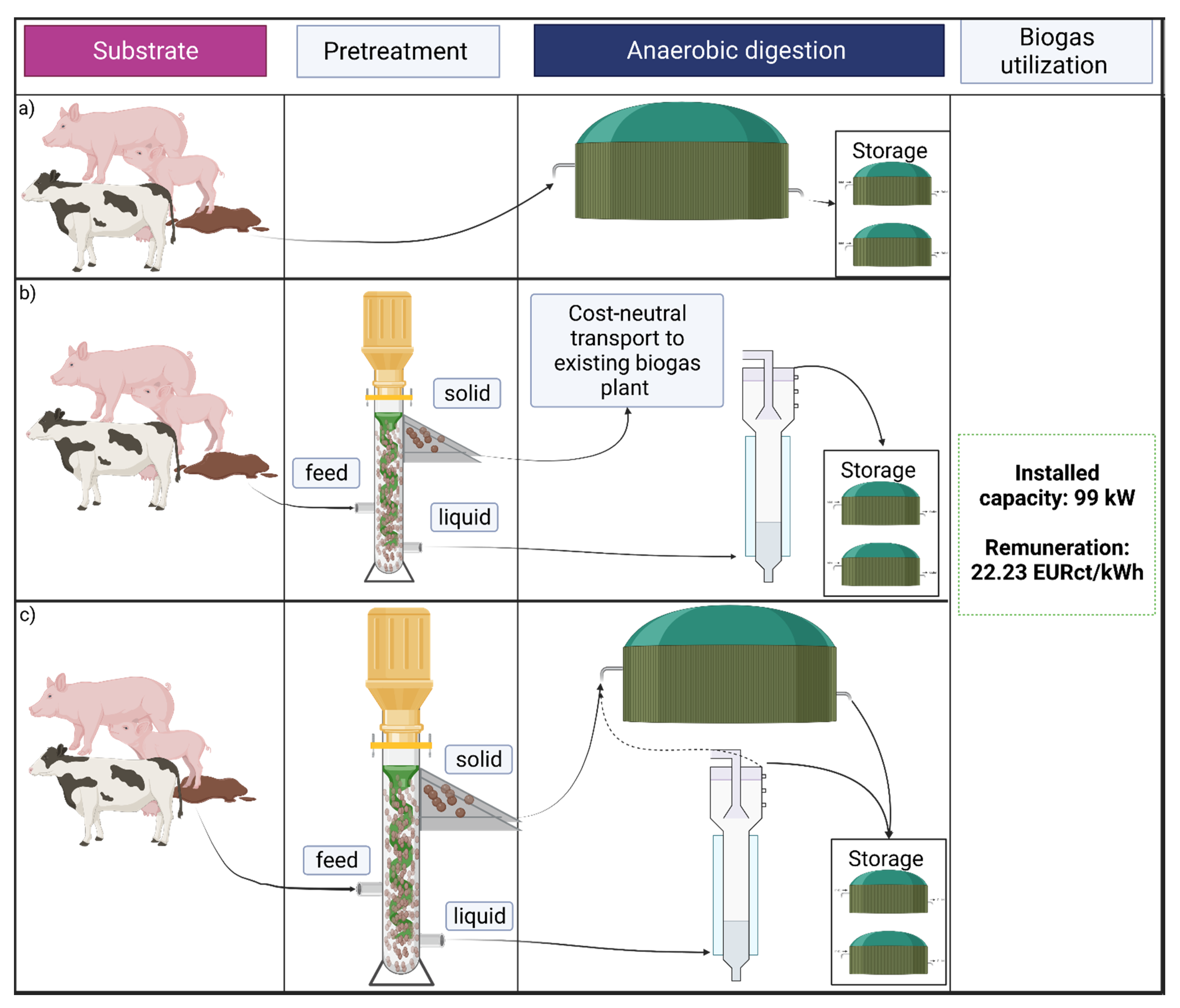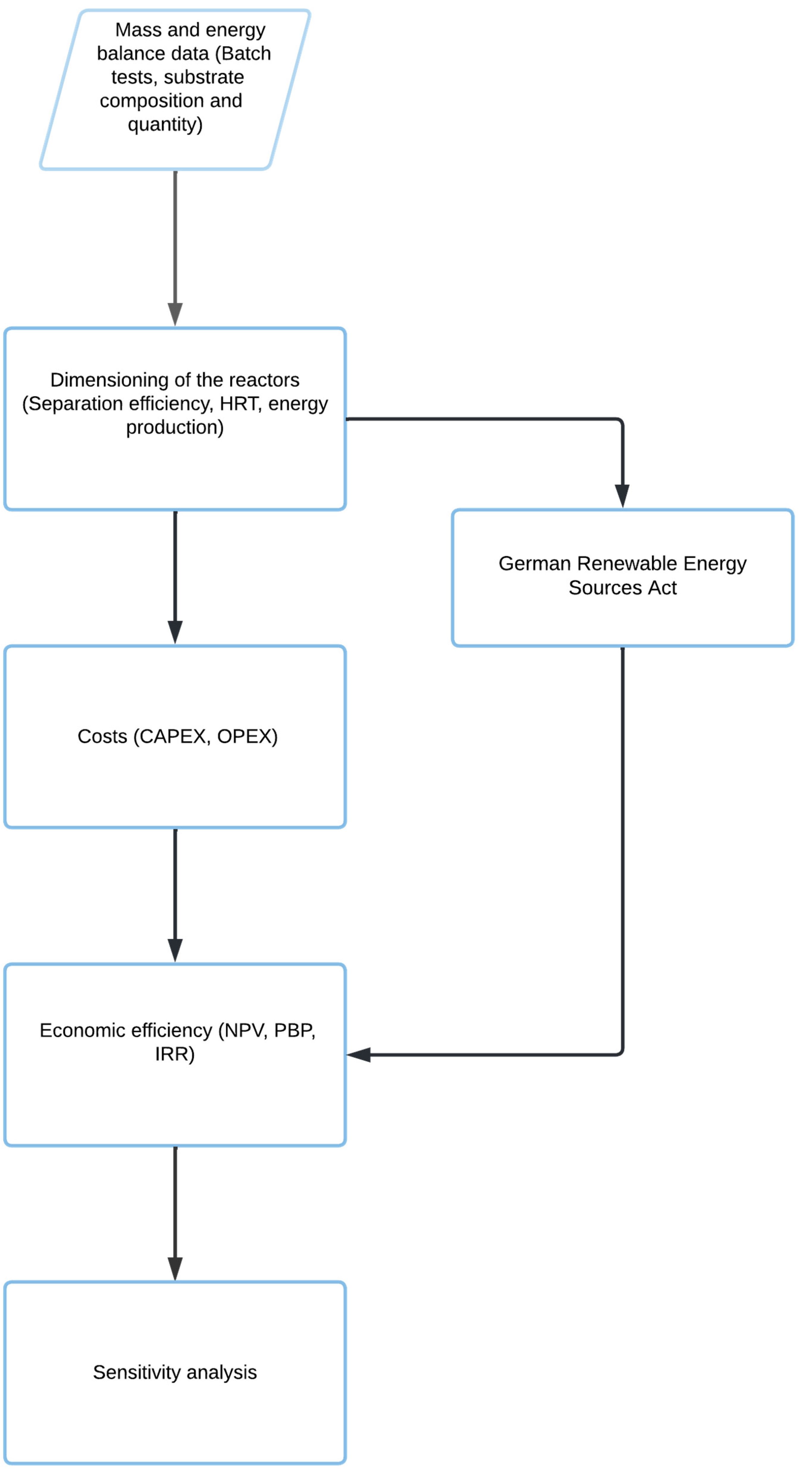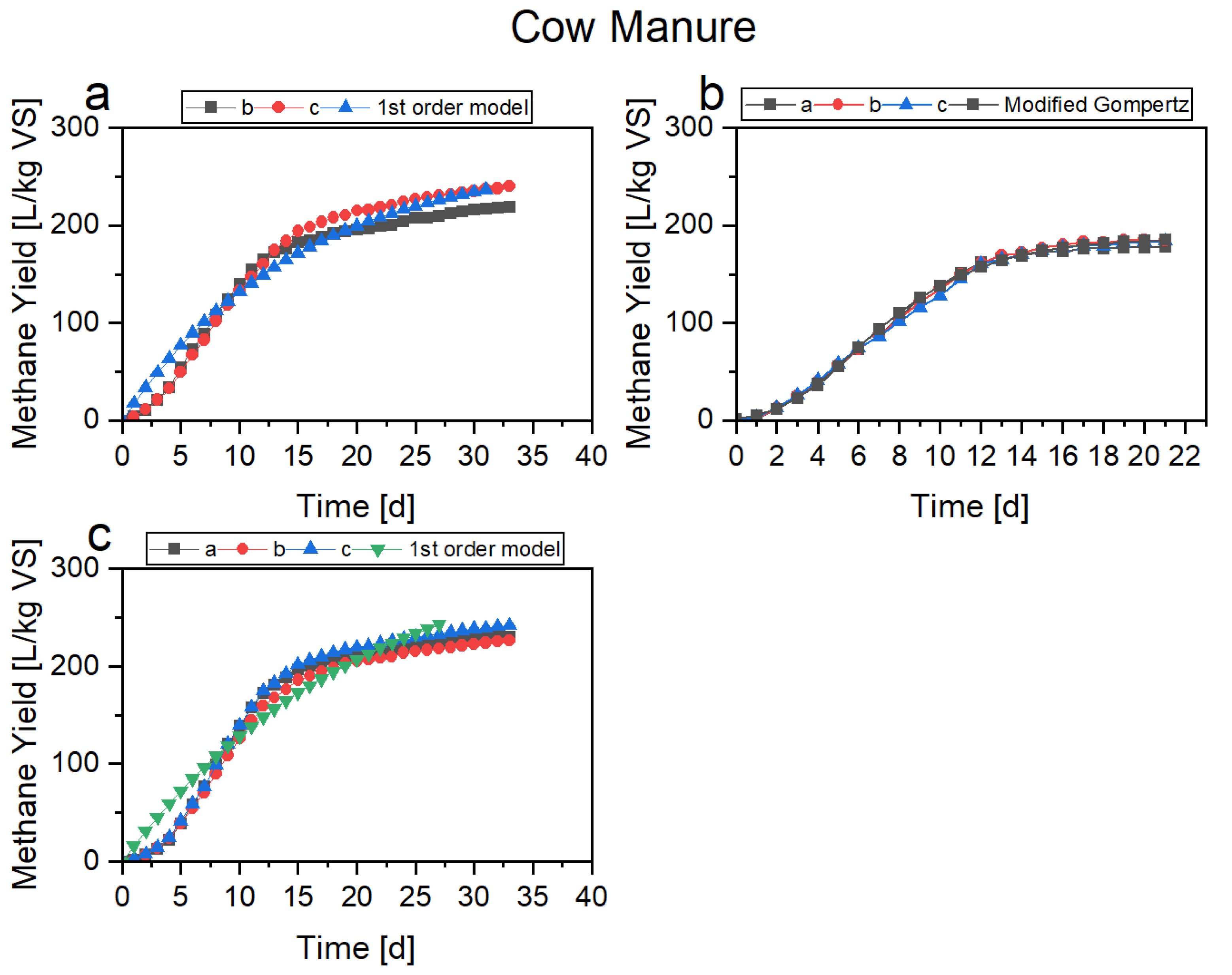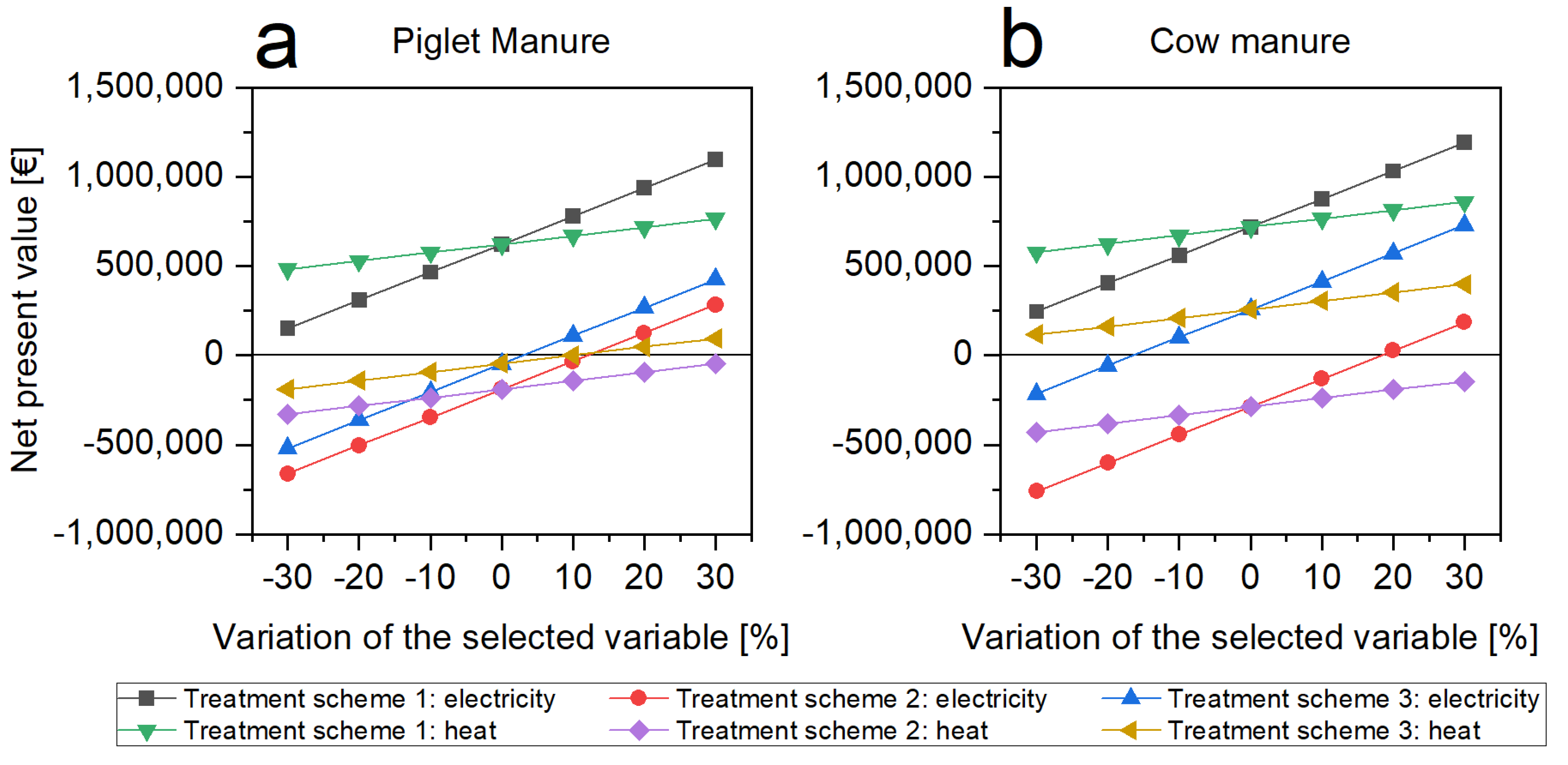Techno-Economic Assessment of Solid–Liquid Biogas Treatment Plants for the Agro-Industrial Sector
Abstract
:1. Introduction
2. Materials and Methods
2.1. Raw Materials
2.2. Setup, Experimental Validation, and Mathematical Modeling of Batch Tests
- Stopping criterion. The test concluded when the relative increase in YCH4 was less than 1% for three consecutive days.
- Plausibility criterion. The existence of abrupt or nonmonotonic trends in the curves requires individual analysis of the affected test.
- Reproducibility/accuracy criterion. After eliminating potential outlier(s) or outlier curve(s), a coefficient of variation (CV) less than 6% between the curves was required.
- The BMP of the positive control (cellulose) was between 85 and 100% of the theoretical BMP (between 352 and 414 NLCH4 kgVS).
2.3. Estimation of HRTs in Continuous Stage
2.4. Economic and Environmental Impact Assessment
2.5. Economic Assessment Calculation Flow Diagram
Sensitivity Analysis
3. Results
3.1. Batch Test Results
3.2. Estimation of Hydraulic Retention Times in Continuous Stage
3.3. Economic Assessment and Sensitivity Analysis
3.3.1. Capital Expenditures
3.3.2. Sensitivity Analysis
4. Discussion
5. Conclusions
Author Contributions
Funding
Institutional Review Board Statement
Informed Consent Statement
Data Availability Statement
Conflicts of Interest
References
- IEA. Global Electricity Demand by Scenario, 2010–2030. Available online: https://www.iea.org/data-and-statistics/charts/global-electricity-demand-by-scenario-2010-2030 (accessed on 18 April 2022).
- Organisation for Economic Co-operation and Development OECD. World Energy Outlook 2020; Organisation for Economic Co-operation and Development OECD: Paris, France, 2020; ISBN 9789264621992. [Google Scholar]
- Smith, P.; Beaumont, L.; Bernacchi, C.J.; Byrne, M.; Cheung, W.; Conant, R.T.; Cotrufo, F.; Feng, X.; Janssens, I.; Jones, H.; et al. Essential outcomes for COP26. Glob. Chang. Biol. 2022, 28, 1–3. [Google Scholar] [CrossRef] [PubMed]
- Arias, P.; Bellouin, N.; Coppola, E.; Jones, R.; Krinner, G.; Marotzke, J.; Naik, V.; Palmer, M.; Plattner, G.-K.; Rogelj, J.; et al. Climate Change 2021: The Physical Science Basis; Contribution of Working Group14 I to the Sixth Assessment Report of the Intergovernmental Panel on Climate Change; Technical Summary; Intergovernmental Panel on Climate Change: Geneva, Switzerland, 2021. [Google Scholar]
- Weiland, P. Biogas production: Current state and perspectives. Appl. Microbiol. Biotechnol. 2010, 85, 849–860. [Google Scholar] [CrossRef] [PubMed]
- Glivin, G.; Kalaiselvan, N.; Mariappan, V.; Premalatha, M.; Murugan, P.C.; Sekhar, J. Conversion of biowaste to biogas: A review of current status on techno-economic challenges, policies, technologies and mitigation to environmental impacts. Fuel 2021, 302, 121153. [Google Scholar] [CrossRef]
- Iglesias, R.; Muñoz, R.; Polanco, M.; Díaz, I.; Susmozas, A.; Moreno, A.D.; Guirado, M.; Carreras, N.; Ballesteros, M. Biogas from Anaerobic Digestion as an Energy Vector: Current Upgrading Development. Energies 2021, 14, 2742. [Google Scholar] [CrossRef]
- German Biogas Association. Biogas Market Data in Germany 2020/2021. Available online: https://www.biogas.org/edcom/webfvb.nsf/id/EN-German-biogas-market-data/$file/21-10-14_Biogasindustryfigures_2020-2021_english.pdf (accessed on 15 December 2021).
- Weinrich, S.; Nelles, M. Basics of Anaerobic Digestion: Biochemical Conversion and Process Modelling; DBFZ Deutsches Biomasseforschungszentrumgemeinnützige GmbH: Leipzig, Germany, 2021; ISBN 978-3-946629-72-6. [Google Scholar]
- Regalado, R.E.H.; Weide, T.; Baumkötter, D.; Wettwer, L.; Häner, J.; Brügging, E.; Tränckner, J. Optimization and Analysis of Liquid Anaerobic Co-Digestion of Agro-Industrial Wastes via Mixture Design. Processes 2021, 9, 877. [Google Scholar] [CrossRef]
- Koch, K.; Hafner, S.D.; Weinrich, S.; Astals, S. Identification of Critical Problems in Biochemical Methane Potential (BMP) Tests From Methane Production Curves. Front. Environ. Sci. 2019, 7, 178. [Google Scholar] [CrossRef]
- Pagés-Díaz, J.; Pereda-Reyes, I.; Taherzadeh, M.J.; Sárvári-Horváth, I.; Lundin, M. Anaerobic co-digestion of solid slaughterhouse wastes with agro-residues: Synergistic and antagonistic interactions determined in batch digestion assays. Chem. Eng. J. 2014, 245, 89–98. [Google Scholar] [CrossRef] [Green Version]
- Raposo, F.; Fernández-Cegrí, V.; de La Rubia, M.A.; Borja, R.; Béline, F.; Cavinato, C.; Demirer, G.; Fernández, B.; Fernández-Polanco, M.; Frigon, J.C.; et al. Biochemical methane potential (BMP) of solid organic substrates: Evaluation of anaerobic biodegradability using data from an international interlaboratory study. J. Chem. Technol. Biotechnol. 2011, 86, 1088–1098. [Google Scholar] [CrossRef]
- Wang, Y.; Yang, L.; Li, Y.; Fu, L.; Yuan, C.; Li, Y.; Luo, J. Reactor performance and economic evaluation of singular, binary, and ternary mixing of feedstocks for anaerobic digestion. Environ. Technol. 2019, 42, 1–11. [Google Scholar] [CrossRef]
- Rajendran, K.; Kankanala, H.R.; Martinsson, R.; Taherzadeh, M.J. Uncertainty over techno-economic potentials of biogas from municipal solid waste (MSW): A case study on an industrial process. Appl. Energy 2014, 125, 84–92. [Google Scholar] [CrossRef] [Green Version]
- de Vrieze, J.; Colica, G.; Pintucci, C.; Sarli, J.; Pedizzi, C.; Willeghems, G.; Bral, A.; Varga, S.; Prat, D.; Peng, L. Resource recovery from pig manure via an integrated approach: A technical and economic assessment for full-scale applications. Bioresour. Technol. 2019, 272, 582–593. [Google Scholar] [CrossRef] [PubMed]
- Rabii, A.; Aldin, S.; Dahman, Y.; Elbeshbishy, E. A review on anaerobic co-digestion with a focus on the microbial populations and the effect of multi-stage digester configuration. Energies 2019, 12, 1106. [Google Scholar] [CrossRef] [Green Version]
- Zhang, C.; Su, H.; Tan, T. Batch and semi-continuous anaerobic digestion of food waste in a dual solid-liquid system. Bioresour. Technol. 2013, 145, 10–16. [Google Scholar] [CrossRef] [PubMed]
- El-Mashad, H.M.; Zhang, R. Biogas production from co-digestion of dairy manure and food waste. Bioresour. Technol. 2010, 101, 4021–4028. [Google Scholar] [CrossRef] [PubMed]
- Guidehouse, T.S.; Beyschlag, L.; Bruhin, A.; Kerres, P.; Lotz, B.; Oppermann, L. Climate Action in Figures (2021) (EN)—BMUV-Publikation: Facts, Trends and Incentives for German Climate Policy 2021 Edition. 2021. Available online: https://www.bmuv.de/publikation/climate-action-in-figures-2021-en (accessed on 13 January 2022).
- VDI 4630; Fermentation of Organic Materials—Characterisation of the Substrate, Sampling, Collection of Material Data, Fermentation Tests. Association of German Engineers: Düsseldorf, Germany, 2016.
- Holliger, C.; Alves, M.; Andrade, D.; Angelidaki, I.; Astals, S.; Baier, U.; Bougrier, C.; Buffière, P.; Carballa, M.; de Wilde, V.; et al. Towards a standardization of biomethane potential tests. Water Sci. Technol. 2016, 74, 2515–2522. [Google Scholar] [CrossRef] [PubMed]
- Holliger, C.; Astals, S.; de Laclos, H.F.; Hafner, S.D.; Koch, K.; Weinrich, S. Towards a standardization of biomethane potential tests: A commentary. Water Sci. Technol. 2021, 83, 247–250. [Google Scholar] [CrossRef]
- Ebner, J.H.; Labatut, R.A.; Lodge, J.S.; Williamson, A.A.; Trabold, T.A. Anaerobic co-digestion of commercial food waste and dairy manure: Characterizing biochemical parameters and synergistic effects. Waste Manag. 2016, 52, 286–294. [Google Scholar] [CrossRef]
- Batstone, D.J.; Tait, S.; Starrenburg, D. Estimation of hydrolysis parameters in full-scale anerobic digesters. Biotechnol. Bioeng. 2009, 102, 1513–1520. [Google Scholar] [CrossRef]
- Weinrich, S. Value of Batch Tests for Biogas Potential Analysis: Method Comparison and Challenges of Substrate and Efficiency Evaluation of Biogas Plants; IEA Bioenergy: Dublin, Ireland, 2018; ISBN 1910154482. [Google Scholar]
- Häner, J.; Weide, T.; Alexander, N.; Regalado, R.E.H.; Wetter, C.; Brügging, E. Anaerobic Digestion of Pig Slurry in Fixed-Bed and Expanded Ganular Sludge Bed Reactors; MDPI: Basel, Switzerland, 2022. [Google Scholar]
- Yu, H.; Wilson, F.; Tay, J.-H. Kinetic analysis of an anaerobic filter treating soybean wastewater. Water Res. 1998, 32, 3341–3352. [Google Scholar] [CrossRef]
- Verma, A.K.; Bhunia, P.; Dash, R.R. Carbonaceous organics removal kinetics in an upflow anaerobic sludge blanket (UASB) reactor treating physico-chemically pre-treated textile wastewater. Desalination Water Treat. 2014, 54, 1–12. [Google Scholar] [CrossRef]
- Jafarzadeh, M.T.; Jamshidi, N.; Talebiazar, L.; Aslaniavali, R. Performance evaluation of an anaerobic hybrid reactor treating petrochemical effluent. Int. J. Geol. 2021, 14, 51–57. [Google Scholar] [CrossRef]
- Regalado, R.E.H.; Häner, J.; Baumkötter, D.; Wettwer, L.; Brügging, E.; Tränckner, J. Continuous Co-Digestion of Agro-Industrial Mixtures in Laboratory Scale Expanded Granular Sludge Bed Reactors. Appl. Sci. 2022, 12, 2295. [Google Scholar] [CrossRef]
- Batstone, D.J.; Puyol, D.; Flores-Alsina, X.; Rodríguez, J. Mathematical modelling of anaerobic digestion processes: Applications and future needs. Rev. Environ. Sci. Biotechnol. 2015, 14, 595–613. [Google Scholar] [CrossRef]
- Cremonez, P.A.; Teleken, J.G.; Weiser Meier, T.R.; Alves, H.J. Two-Stage anaerobic digestion in agroindustrial waste treatment: A review. J. Environ. Manag. 2021, 281, 111854. [Google Scholar] [CrossRef] [PubMed]
- Alfonso-Cardero, A.; Pagés-Díaz, J.; Kalogirou, E.; Psomopoulos, C.S.; Lorenzo-Llanes, J. To dream or not to dream in Havana: Multi-criteria decision-making for material and energy recovery from municipal solid wastes. Environ. Sci. Pollut. Res. Int. 2021, 1–16. [Google Scholar] [CrossRef]
- Grantham Research Institute on Climate Change and the Environment. Renewable Energy Sources Act: EEG; Grantham Research Institute on Climate Change and the Environment: London, UK, 2021. [Google Scholar]
- Brennan, D.J. Process Industry Economics: Principles, Concepts and Applications, 2nd ed.; Elsevier: San Diego, CA, USA, 2020; ISBN 9780128195604. [Google Scholar]
- Alfonso-Cardero, A.; Pagés-Díaz, J.; Contino, F.; Rajendran, K.; Lorenzo-Llanes, J. Process simulation and techno-economic assessment of vinasse-to-biogas in Cuba: Deterministic and uncertainty analysis. Chem. Eng. Res. Des. 2021, 169, 33–45. [Google Scholar] [CrossRef]
- Don, W.G.; Robert, H.P. Perry’s Chemical Engineers’ Handbook, 8th ed.; McGraw-Hill: New York, NY, USA, 2008; ISBN 9780071422949. [Google Scholar]
- Rico, J.L.; García, H.; Rico, C.; Tejero, I. Characterisation of solid and liquid fractions of dairy manure with regard to their component distribution and methane production. Bioresour. Technol. 2007, 98, 971–979. [Google Scholar] [CrossRef]
- Weinrich, S.; Nelles, M. Systematic simplification of the Anaerobic Digestion Model No. 1 (ADM1)—Model development and stoichiometric analysis. Bioresour. Technol. 2021, 333, 125124. [Google Scholar] [CrossRef]
- Ruile, S.; Schmitz, S.; Mönch-Tegeder, M.; Oechsner, H. Degradation efficiency of agricultural biogas plants—A full-scale study. Bioresour. Technol. 2015, 178, 341–349. [Google Scholar] [CrossRef]
- Tallou, A.; Haouas, A.; Jamali, M.Y.; Atif, K.; Amir, S.; Aziz, F. Review on Cow Manure as Renewable Energy. In Smart Village Technology: Concepts and Developments, 1st ed.; Patnaik, S., Sen, S., Mahmoud, M.S., Eds.; Springer: Cham, Switzerland, 2020; pp. 341–352. ISBN 978-3-030-37794-6. [Google Scholar]
- Neshat, S.A.; Mohammadi, M.; Najafpour, G.D.; Lahijani, P. Anaerobic co-digestion of animal manures and lignocellulosic residues as a potent approach for sustainable biogas production. Renew. Sustain. Energy Rev. 2017, 79, 308–322. [Google Scholar] [CrossRef]
- Mata-Alvarez, J.; Dosta, J.; Romero-Güiza, M.S.; Fonoll, X.; Peces, M.; Astals, S. A critical review on anaerobic co-digestion achievements between 2010 and 2013. Renew. Sustain. Energy Rev. 2014, 36, 412–427. [Google Scholar] [CrossRef]
- Jurado, E.; Antonopoulou, G.; Lyberatos, G.; Gavala, H.N.; Skiadas, I.V. Continuous anaerobic digestion of swine manure: ADM1-based modelling and effect of addition of swine manure fibers pretreated with aqueous ammonia soaking. Appl. Energy 2016, 172, 190–198. [Google Scholar] [CrossRef] [Green Version]
- Rodriguez-Verde, I.; Regueiro, L.; Carballa, M.; Hospido, A.; Lema, J.M. Assessing anaerobic co-digestion of pig manure with agroindustrial wastes: The link between environmental impacts and operational parameters. Sci. Total Environ. 2014, 497–498, 475–483. [Google Scholar] [CrossRef]
- Van, D.P.; Fujiwara, T.; Leu Tho, B.; Song Toan, P.P.; Hoang Minh, G. A review of anaerobic digestion systems for biodegradable waste: Configurations, operating parameters, and current trends. Environ. Eng. Res. 2020, 25, 1–17. [Google Scholar] [CrossRef] [Green Version]
- Rocamora, I.; Wagland, S.T.; Villa, R.; Simpson, E.W.; Fernández, O.; Bajón-Fernández, Y. Dry anaerobic digestion of organic waste: A review of operational parameters and their impact on process performance. Bioresour. Technol. 2020, 299, 122681. [Google Scholar] [CrossRef] [PubMed]
- Weide, T. Biochemical Conversion of Liquid, Biogenous Waste Resources via Anaerobic High Performance Reactors for the Optimization of Conventional Biogas Processes. 2017. Available online: https://www.hb.fh-muenster.de/opus4/frontdoor/index/index/start/27/rows/10/sortfield/score/sortorder/desc/searchtype/simple/query/wetter/author_facetfq/Wetter%2C+Christof/yearfq/2017/docId/8834 (accessed on 18 April 2022).
- Rico, C.; Rico, J.L.; Lasa, C. Anaerobic digestion of the liquid fraction of dairy manure separated by screw pressing and centrifugation in a upflow anaerobic sludge blanket reactor at 25 °C. Biosyst. Eng. 2012, 112, 344–351. [Google Scholar] [CrossRef]
- Rico, C.; Montes, J.A.; Rico, J.L. Evaluation of different types of anaerobic seed sludge for the high rate anaerobic digestion of pig slurry in UASB reactors. Bioresour. Technol. 2017, 238, 147–156. [Google Scholar] [CrossRef] [PubMed] [Green Version]
- Castrillón, L.; Vázquez, I.; Marañón, E.; Sastre, H. Anaerobic thermophilic treatment of cattle manure in UASB reactors. Waste Manag. Res. 2002, 20, 350–356. [Google Scholar] [CrossRef] [Green Version]
- Marañón, E.; Castrillón, L.; Vázquez, I.; Sastre, H. The influence of hydraulic residence time on the treatment of cattle manure in UASB reactors. Waste Manag. Res. 2001, 19, 436–441. [Google Scholar] [CrossRef]
- Lee, Y.-S.; Han, G.-B. Pig slurry treatment by a hybrid multi-stage unit system consisting of an ATAD and an EGSB followed by a SBR reactor. Biosyst. Eng. 2012, 111, 243–250. [Google Scholar] [CrossRef]
- Peters, M.S.; Timmerhaus, K.D. Plant Design and Economics for Chemical Engineers, 4th ed.; McGraw-Hill: New York, NY, USA, 1991; ISBN 9780070496132. [Google Scholar]
- Amigun, B.; von Blottnitz, H. Capital cost prediction for biogas installations in Africa: Lang factor approach. Environ. Prog. Sustain. Energy 2009, 28, 134–142. [Google Scholar] [CrossRef]
- Vo, T.T.; Wall, D.M.; Ring, D.; Rajendran, K.; Murphy, J.D. Techno-economic analysis of biogas upgrading via amine scrubber, carbon capture and ex-situ methanation. Appl. Energy 2018, 212, 1191–1202. [Google Scholar] [CrossRef]
- Ndyabawe, K.; Kisaalita, W.S. Validity of the Africa-wide Lang factor of 2.63 for estimating small biogas plant installation costs in Uganda. Int. J. Agric. Biol. Eng. 2014, 7, 70–76. [Google Scholar] [CrossRef]
- Balussou, D.; Kleyböcker, A.; McKenna, R.; Möst, D.; Fichtner, W. An Economic Analysis of Three Operational Co-digestion Biogas Plants in Germany. Waste Biomass Valor. 2012, 3, 23–41. [Google Scholar] [CrossRef] [Green Version]
- Sinnott, R.K.; Towler, G.P. Chemical Engineering Design: SI Edition, 6th ed.; Butterworth-Heinemann, Elsevier: Oxford, UK, 2020; ISBN 9780081026007. [Google Scholar]
- Teixeira Corrêia, G.; Pérez-Pérez, T.; Pereda-Reyes, I.; Merencio, D.O.; Zaiat, M.; Kwong, W.H. Mathematical Modeling of the Hydrodynamics of an EGSB Reactor. J. Chem. Chem. Eng. 2014, 8, 602–610. [Google Scholar]
- Cruz-Salomón, A.; Ríos-Valdovinos, E.; Pola-Albores, F.; Lagunas-Rivera, S.; Meza-Gordillo, R.; Ruíz-Valdiviezo, V. Evaluation of Hydraulic Retention Time on Treatment of Coffee Processing Wastewater (CPWW) in EGSB Bioreactor. Sustainability 2018, 10, 83. [Google Scholar] [CrossRef] [Green Version]
- Londoño, Y.A.; Castrillón, L.V.; Pino, N.J.; Chica, E.L.; Peñuela, G.A. Analysis and Modeling of the Hydraulic Behavior of EGSB Reactors with Presence and Absence of Granular Biomass at Different Hydraulic Retention Times. Ing. Investig. 2019, 39. [Google Scholar] [CrossRef] [Green Version]
- tttStrompreise. Available online: https://www.stromauskunft.de/strompreise/ (accessed on 11 April 2022).
- Liebetrau, J.; O’Shea, R.; Wellisch, M.; Lyng, K.-A.; Bochmann, G.; McCabe, B.K.; Harris, P.W.; Lukehurst, C.; Kornatz, P.; Murphy, J.D. Potential and Utilization of Manure to Generate Biogas in Seven Countries; IEA Bioenergy: Paris, France, 2021. [Google Scholar]
- Bywater, A.; Kusch-Brandt, S. Exploring Farm Anaerobic Digester Economic Viability in a Time of Policy Change in the UK. Processes 2022, 10, 212. [Google Scholar] [CrossRef]
- Majer, S.; Kornatz, P.; Daniel-Gromke, J.; Rensberg, N.; Brosowski, A.; Oehmichen, K.; Liebetrau, J. (Eds.) Stand und Perspektiven der Biogaserzeugung aus Gülle; Deutsches Biomasseforschungszentrum Gemeinnützige GmbH: Leipzig, Germany, 2019; ISBN 9783946629481. [Google Scholar]
- Cruz-Salomón, A.; Ríos-Valdovinos, E.; Pola-Albores, F.; Lagunas-Rivera, S.; Meza-Gordillo, R.; Ruíz-Valdiviezo, V.M.; Cruz-Salomón, K.C. Expanded granular sludge bed bioreactor in wastewater treatment. Glob. J. Environ. Sci. Manag. 2019, 5, 119–138. [Google Scholar] [CrossRef]
- Mahmoud, N.; Zeeman, G.; Gijzen, H.; Lettinga, G. Solids removal in upflow anaerobic reactors, a review. Bioresour. Technol. 2003, 90, 1–9. [Google Scholar] [CrossRef]
- Ratanatamskul, C.; Siritiewsri, T. A compact on-site UASB–EGSB system for organic and suspended solid digestion and biogas recovery from department store wastewater. Int. Biodeterior. Biodegrad. 2015, 102, 24–30. [Google Scholar] [CrossRef]
- van der Last, A.R.M.; Lettinga, G. Anaerobic Treatment of Domestic Sewage under Moderate Climatic (Dutch) Conditions Using Upflow Reactors at Increased Superficial Velocities. Water Sci. Technol. 1992, 25, 167–178. [Google Scholar] [CrossRef]
- Fuentes, M.; Scenna, N.J.; Aguirre, P.A. A coupling model for EGSB bioreactors: Hydrodynamics and anaerobic digestion processes. Chem. Eng. Process. Process Intensif. 2011, 50, 316–324. [Google Scholar] [CrossRef]
- López, I.; Borzacconi, L. Modelling of an EGSB treating sugarcane vinasse using first-order variable kinetics. Water Sci. Technol. 2011, 64, 2080–2088. [Google Scholar] [CrossRef] [PubMed]
- Bhattacharyya, D.; Singh, K.S. Understanding the Mixing Pattern in an Anaerobic Expanded Granular Sludge Bed Reactor: Effect of Liquid Recirculation. J. Environ. Eng. 2010, 136, 576–584. [Google Scholar] [CrossRef]
- Pérez-Pérez, T.; Correia, G.T.; Kwong, W.H.; Pereda-Reyes, I.; Oliva-Merencio, D.; Zaiat, M. Effects of the support material addition on the hydrodynamic behavior of an anaerobic expanded granular sludge bed reactor. J. Environ. Sci. 2017, 54, 224–230. [Google Scholar] [CrossRef] [PubMed]
- Khanal, S.K. Anaerobic Biotechnology for Bioenergy Production: Principles and Applications; Wiley-Blackwell: Ames, IA, USA, 2008. [Google Scholar]
- Kougias, P.G.; Angelidaki, I. Biogas and its opportunities—A review. Front. Environ. Sci. Eng. 2018, 12, 14. [Google Scholar] [CrossRef]
- Prapaspongsa, T.; Poulsen, T.G.; Hansen, J.A.; Christensen, P. Energy production, nutrient recovery and greenhouse gas emission potentials from integrated pig manure management systems. Waste Manag. Res. 2010, 28, 411–422. [Google Scholar] [CrossRef]
- Dareioti, M.A.; Vavouraki, A.I.; Tsigkou, K.; Kornaros, M. Assessment of Single- vs. Two-Stage Process for the Anaerobic Digestion of Liquid Cow Manure and Cheese Whey. Energies 2021, 14, 5423. [Google Scholar] [CrossRef]
- Theuerl, S.; Herrmann, C.; Heiermann, M.; Grundmann, P.; Landwehr, N.; Kreidenweis, U.; Prochnow, A. The Future Agricultural Biogas Plant in Germany: A Vision. Energies 2019, 12, 396. [Google Scholar] [CrossRef] [Green Version]
- Schievano, A.; Tenca, A.; Scaglia, B.; Merlino, G.; Rizzi, A.; Daffonchio, D.; Oberti, R.; Adani, F. Two-stage vs single-stage thermophilic anaerobic digestion: Comparison of energy production and biodegradation efficiencies. Environ. Sci. Technol. 2012, 46, 8502–8510. [Google Scholar] [CrossRef] [PubMed]
- Panichnumsin, P.; Nopharatana, A.; Ahring, B.K.; Chaiprasert, P. Enhanced biomethanation in co-digestion of Cassava pulp and pig manure using a two-phase anaerobic system. J. Sustain. Energy Environ. 2012, 3, 73–79. [Google Scholar]
- Demirer, G.N.; Chen, S. Two-phase anaerobic digestion of unscreened dairy manure. Process Biochem. 2005, 40, 3542–3549. [Google Scholar] [CrossRef]
- Nielsen, H.B.; Mladenovska, Z.; Westermann, P.; Ahring, B.K. Comparison of two-stage thermophilic (68 °C/55 °C) anaerobic digestion with one-stage thermophilic (55 °C) digestion of cattle manure. Biotechnol. Bioeng. 2004, 86, 291–300. [Google Scholar] [CrossRef]







| Variable | Piglet Manure | Cow Manure | ||||
|---|---|---|---|---|---|---|
| Solid | Raw | Liquid | Solid | Raw | Liquid | |
| DM/FM (wt%) | 17.50 | 3.80 | 1.80 | 26.70 | 7.30 | 5.30 |
| VS/FM (wt%) | 90.13 | 67.90 | 58.33 | 89.03 | 78.50 | 69.81 |
| VS/DM (wt%) | 15.77 | 2.58 | 1.05 | 23.77 | 5.73 | 3.70 |
| Crude protein/FM (wt%) | 2.40 | 2.50 | 0.80 | 2.50 | 2.40 | 2.60 |
| Crude fat/FM (wt%) | 0.40 | 0.30 | 0.25 | 0.30 | 0.30 | 0.30 |
| Crude fiber/FM (wt%) | 5.70 | 0.00 | 0.00 | 9.30 | 1.40 | 0.00 |
| Free nitrogen extracts/FM (wt%) | 7.50 | 0.00 | 0.00 | 11.70 | 1.60 | 0.80 |
| ash/FM (wt%) | 1.50 | 1.00 | 0.75 | 2.90 | 1.60 | 1.60 |
| Parameter | Piglet Manure Solid | Piglet Manure Raw | Cow Manure Solid | Cow Manure Raw |
|---|---|---|---|---|
| BMP∞ (LCH4/kgVS) | 280.85 | 359.77 | 327.31 | 270.98 |
| k (1/d) | 0.05 | 0.14 | 0.05 | 0.07 |
| RMSE (LCH4/kgVS) | 12.74 | 3.17 | 18.16 | 13.31 |
| MYAVG (LCH4/kgVS) | 229.80 | 356.24 | 224.49 | 227.30 |
| fd | 0.82 | 0.99 | 0.68 | 0.84 |
| Time (d) | 39 | 27 | 27 | 31 |
| Parameter | Piglet Manure Solid | Piglet Manure Raw | Cow Manure Solid | Cow Manure Raw |
|---|---|---|---|---|
| MY | 224.68 | 287.81 | 224.49 | 216.78 |
| HRT | 81.80 | 28.06 | 79.91 | 59.99 |
| Substrate | DM/FM (wt%) | CODaverage (gCOD/L) | OLR Interval (gCOD/L/d) | HRT Interval (d) |
|---|---|---|---|---|
| Piglet manure liquid | 1.80 | 25.48 | [4.63–5.77] | [4.41–5.50] |
| Cow manure liquid | 5.30 | 28.06 | [1.73–2.15] | [13.00–16.20] |
| Substrate | Reactor Type | Temperature (°C) | OLRmax (gCOD/L/d) | HRTmin (d) | Reference |
|---|---|---|---|---|---|
| Pig manure hydrolysates | EGSB | 35 | 21 | 1.5 | [46] |
| Separated pig manure | FB | 40 | 1.82 | 18 | [49] |
| Liquid fraction of dairy manure | UASB | 25 | 0.65 | 34.8 | [50] |
| Pig slurry | UASB | 36 | 16.4 | 1.5 | [51] |
| Cattle manure | UASB | 55 | 5.06 | 7.3 | [52] |
| Cattle manure | UASB | 37 | 8.63 | 5.3 | [53] |
| Pig slurry | ATAD + EGSB + SBR | 35 | 5.00 | 6.96 | [54] |
| Filtered pig slurry | FB | 40 | 13.5 | 1.7 | [27] |
| Filtered pig slurry | EGSB | 40 | 8.1 | 3.0 | [27] |
| Capital Expenditure (EUR) | Treatment Scheme 1 | Treatment Scheme 2 | Treatment Scheme 3 | |||
|---|---|---|---|---|---|---|
| Piglet Manure | Cow Manure | Piglet Manure | Cow Manure | Piglet Manure | Cow Manure | |
| EGSB reactor and associated costs | - | - | 241,153 | 361,016 | 213,157 | 232,913 |
| CSTR and associated costs | 181,644 | 204,927 | - | - | 74,190 | 87,583 |
| Separator | - | - | 10,378 | 17,368 | 8596 | 11,200 |
| Combined heat and power unit | 175,000 | 175,000 | 175,000 | 175,000 | 175,000 | 175,000 |
| Lang factor for the fixed plant cost | 2.69 | 2.69 | 2.69 | 2.69 | 2.69 | 2.69 |
| Total Invest | 959,372 | 1,022,004 | 1,147,368 | 1,488,603 | 1,266,837 | 1,363,012 |
| Operational Expenditures (EUR/Year) | Treatment Scheme 1 | Treatment Scheme 2 | Treatment Scheme 3 | |||
|---|---|---|---|---|---|---|
| Piglet Manure | Cow Manure | Piglet Manure | Cow Manure | Piglet Manure | Cow Manure | |
| Electricity costs | 24,974 | 13,279 | 90,353 | 65,682 | 66,002 | 28,076 |
| Wage rate | 5475 | 5475 | 5475 | 5475 | 5475 | 5475 |
| Transport costs raw manure | 13,875 | 6221 | 21,083 | 17,231 | 15,401 | 5524 |
| Internal power consumption | 10,193 | 10,944 | 10,927 | 10,927 | 10,193 | 10,944 |
| Total operational costs | 54,516 | 35,919 | 127,837 | 99,314 | 97,071 | 50,019 |
| Dynamic Economic Indicator | Treatment Scheme 1 | Treatment Scheme 2 | Treatment Scheme 3 | |||
|---|---|---|---|---|---|---|
| Piglet Manure | Cow Manure | Piglet Manure | Cow Manure | Piglet Manure | Cow Manure | |
| Net present value (EUR) | 622,383 | 718,084 | −189,836 | −288,237 | −47,373 | 257,034 |
| Internal return rate (%) | 18.70 | 19.40 | 7.49 | 7.00 | 9.44 | 12.67 |
Publisher’s Note: MDPI stays neutral with regard to jurisdictional claims in published maps and institutional affiliations. |
© 2022 by the authors. Licensee MDPI, Basel, Switzerland. This article is an open access article distributed under the terms and conditions of the Creative Commons Attribution (CC BY) license (https://creativecommons.org/licenses/by/4.0/).
Share and Cite
Hernández Regalado, R.E.; Häner, J.; Brügging, E.; Tränckner, J. Techno-Economic Assessment of Solid–Liquid Biogas Treatment Plants for the Agro-Industrial Sector. Energies 2022, 15, 4413. https://doi.org/10.3390/en15124413
Hernández Regalado RE, Häner J, Brügging E, Tränckner J. Techno-Economic Assessment of Solid–Liquid Biogas Treatment Plants for the Agro-Industrial Sector. Energies. 2022; 15(12):4413. https://doi.org/10.3390/en15124413
Chicago/Turabian StyleHernández Regalado, Roberto Eloy, Jurek Häner, Elmar Brügging, and Jens Tränckner. 2022. "Techno-Economic Assessment of Solid–Liquid Biogas Treatment Plants for the Agro-Industrial Sector" Energies 15, no. 12: 4413. https://doi.org/10.3390/en15124413
APA StyleHernández Regalado, R. E., Häner, J., Brügging, E., & Tränckner, J. (2022). Techno-Economic Assessment of Solid–Liquid Biogas Treatment Plants for the Agro-Industrial Sector. Energies, 15(12), 4413. https://doi.org/10.3390/en15124413








